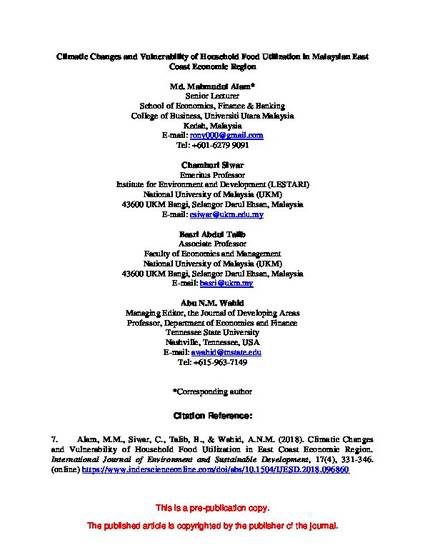
Article
Climatic Changes and Vulnerability of Household Food Utilization in Malaysian East Coast Economic Region
International Journal of Environment and Sustainable Development
(2018)
Abstract
Sustainable food security at household level is one of the emerging issues for all nations. There are several factors such as social, economic, political, demographic, natural, and livelihood strategies that causes to the vulnerability of the status of household food security. Therefore examining the vulnerability of these factors is essential to identify the reason and recognize the most vulnerable communities. This study is an attempt to study on the vulnerability of the factors of household food utilization and its linkage with climatic changes in Malaysia. The study is based on primary data collected in the months of July – October, 2012 through a questionnaire survey on 460 low income households from East Coast Economic Region (ECER) in Malaysia. The samples were selected from E-Kasih poor household database, based on cluster random sampling technique. The study found that the vulnerability of the factors of household food utilization has increased statistically significantly over the last five years period due to difference between rural and city food quality, occurrences of natural disasters, incidences of mosquitoes, insects, pest, etc., and diseases like dengue, malaria, heat stretch, cold, skin disease, etc. This study suggests that the food security programs need to be integrated with climatic change adaptation programs to ensure more effective and sustainable household food security in future, especially among the poor and low income group.
Keywords
- Climatic Changes; Household Food Security; Food Utilization; Vulnerability; Poverty
Disciplines
Publication Date
2018
DOI
10.1504/IJESD.2018.096860
Citation Information
Alam, M.M., Siwar, C., Talib, B., & Wahid, A.N.M. (2018). Climatic Changes and Vulnerability of Household Food Utilization in East Coast Economic Region. International Journal of Environment and Sustainable Development, 17(4), 331-346.
